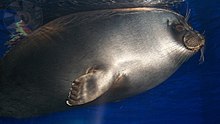Baikal Museum
 Limnological Institute (2009) |
|
| Data | |
|---|---|
| place |
Listvyanka , Russia |
| Art |
Natural History Museum
|
| opening | 1993 |
| Number of visitors (annually) | approx. 150,000 |
| operator |
Russian Academy of Sciences
|
| management |
Vladimir Abramovich Fialkov
|
| Website | |
The Baikal Museum (full name Baikal Museum at the Irkutsk Scientific Center of the Siberian Branch of the Russian Academy of Sciences , Russian Байкальский Музей Иркутского научного центра Сибирского отделения Российской академии наук ) is a Russian , public and non-commercial natural history museum , located about 70 kilometers southeast of Irkutsk is located in Listvyanka . It illuminates Lake Baikal with its flora and fauna from all scientific perspectives and is one of three museums worldwide that are exclusively dedicated to one lake. One attraction is a mini-submarine that simulates a dive into the depths of the lake. An arboretum next to the building displays around 400 species of plants, some of which are rare or endangered. In front of the museum there is a monument to the dramaturge and writer Alexander Vampilow .
history
The first exhibition devoted to the beginnings of the life and studies of Lake Baikal was developed at the same time as the Russian Academy of Science organized the Baikal expedition in 1925. From 1928 it was expanded and improved in the limnological station of the Academy of Sciences of the USSR . In 1961, after the establishment of the Limnological Institute of the Academy of Sciences of the USSR, the exhibition showed exhibits collected during scientific expeditions such as baikail fish, prepared birds and animals, sediment and mineral samples from the Baikal and various artifacts . In 1993 the museum became an independent structure within the Siberian Department of the Russian Academy of Sciences. The museum was based on the museum exposition of the Limnological Institute of the Siberian Department of the Russian Academy of Sciences. In 2001 the renovation of the museum began. In June 2004 the Aquarium Complex exhibition opened. Eleven limnological aquariums show, almost naturally, the underwater world of Baikal. The water temperature is kept constant at 4 degrees by pumps that deliver the liquid four times a day from a depth of 500 m. Two Baikal seals live in two interconnected rooms with ice floes. In 2006 the exhibition Virtual dive to the bottom of Lake Baikal opened . In a submarine model for 22 visitors, a dive from the surface of the lake to the maximum depth of 1637 m is simulated on nine monitors with video material from two expeditions. In 2008 the arboretum and the ecological education center were opened. In 2010 the community center was made available to the public. 40 aquariums, which are also supplied with Baikal water, are used to research life cycles and develop methodological principles for the cultivation of endemic Baikal organisms under the most natural conditions possible. The arboretum offered the opportunity to explore rare and endangered plant species in the Baikal region.
Since the museum was founded, the number of employees has increased from 12 (1993) to 59 (2013). These include ten scientific employees, two doctors and eight scientific candidates . Since 2010, the facility has issued 224 scientific publications. From 2008 to 2013 the museum organized five national and international conferences. The number of visitors grew from 30,000 (1993) to 100,000 (2012). In 2017, 160,000 visitors were counted. Extensive extensions to the museum are planned for the coming years.
Exhibitions


The following exhibition will be shown (as of 2017):
- History of the evolution of the earth
- Formation of Lake Baikal
- Flora and fauna of Lake Baikal
- Environment of Lake Baikal
- Natural territories particularly worthy of protection
- History of the exploration of Lake Baikal
- Virtual dive to the bottom of Lake Baikal
- Aquariums
- Underwater research
- Arboretum
- Lifeworld of Lake Baikal under the microscope
- Nerpa Online
Web links
Individual evidence
- ↑ Планы развития Байкальского музея ИНЦ СО РАН. Retrieved January 27, 2018 (Russian).
- ↑ Структура музея. Retrieved January 27, 2018 (Russian).
- ↑ a b The Baikal Museum of ISC SB RAS. Retrieved January 27, 2018 .
- ^ Baikal Museum - Museum in Listvyanka. Lonely Planet , accessed January 27, 2018 .
- ↑ Краткая история создания и становления Байкальского музея. Retrieved January 28, 2018 (Russian).
